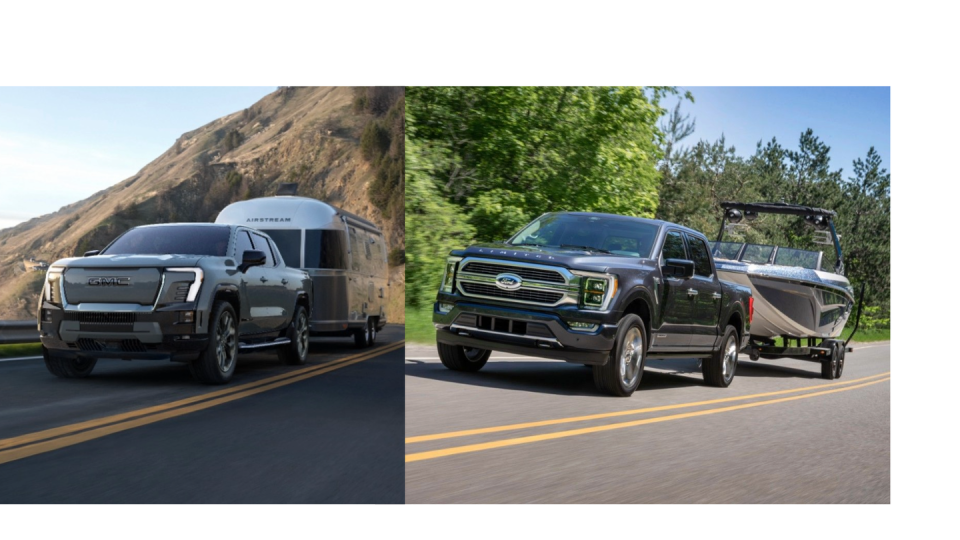Ford Leans on Hybrids While GM Banks on EV Profitability

Presentations from General Motors and Ford at this week’s Barclays Global Automotive and Mobility Tech Conference in New York provide insight into what we will drive between now and the end of the ‘20s.
As EV demand fluctuates, Ford CFO John Lawler said “hybrids are going to be critical.” No one is going to put a fifth-wheel on an EV, he said, but buyers will put a big trailer on a hybrid truck.
GM CFO Paul Jacobson reiterated challenges in the EV ramp-up, mostly problems with the automated technology and machinery to stack battery cells into modules. By the middle of 2024, “we expect that to be normalized and no longer a constraint,” he said.
John Lawler and Paul Jacobson, chief financial officers, respectively, of the Ford Motor Company and General Motors, agree the US market will buy about 16 million new vehicles next year. Their companies are on different paths toward the electric-vehicle revolution.
Each spoke individually before the Barclays Global Automotive and Mobility Tech Conference in New York this week. Jacobson repeated much of what he and CEO Mary Barra presented in Wednesday’s GM business update, but with more detail.
Jacobson said he expects “spending on Cruise (automated vehicles) will be significantly lower than what it was in 2023.”
Scaling back autonomous-vehicle programs may be another subject on which the two companies agree.
Lawler said Ford “was sinking $1 billion per year” into Level 4 autonomous development when it dropped Argo AI last year to concentrate instead on Level 2+ and Level 3 technology, and “now we have the highest-rated driver-assist technology with Blue Cruise.”
Yes, Lawler and Jacobson were talking to a Wall Street crowd, where few drive their own cars or trucks. But their presentations provide insight into what we will drive between now and the end of the ‘20s.
Ford
EV growth is slowing, Lawler said, so Ford is investing less.
“Pricing has come down much quicker than we expected and than anybody has expected,” he told the Wall Street crowd. The EV market is shifting from early adopters to what he calls an “early majority”—consumers who are not willing to pay premium prices for EVs.
But Ford is changing its EV tactics, not its strategy. It is already a leader in hybrid pickups in the US, Lawler said, available in the F-150 and Maverick, and will offer hybrid versions in more than 50% of its product mix for 2024.
As EV demand fluctuates, “hybrids are going to be critical.” No one is going to put a fifth-wheel on an EV, Lawler said, but buyers will put a big trailer on a hybrid truck.
Ford’s Model-e business unit continues to advance, however, with engineers and designers working on the company’s third-generation battery-electric vehicles as Gen II BEVs roll out. Unlike the F-150 Lightning and e-Transit trucks, second- and third-generation models are “clean-sheet” EVs, with optimized batteries for fewer kilowatts per mile, optimized aerodynamics, etc. Model-e’s profit margin target is 8% by 2026-27, he said.
But it’s Ford’s Pro commercial truck and van unit (ICE and EV) that leads the company as the industry leader in North America and Europe. The Inflation Reduction Act and CHIPS Act in the US are “driving a lot of demand for Pro orders,” Lawler said.

Demand for Pro models is outstripping supply, Lawler said, but inventories of Ford Blue (the gas-powered Mustangs and F-150s and Lincolns) are stabilizing, though with some lingering supply chain shortages.
“We continue to have price competition as we go through 2024, but not a lot,” he said. Average monthly new vehicle payments equaled about 13.5% of average income in 2019, but was up to 15.7% in 2022, and has since come down to about 14.5%. Lawler expects it will soon drop back to 13.5%, which will drive prices down about $1800 on average.
General Motors
CEO Mary Barra didn’t say it directly, but Jacobson confirmed to the Barclay conference this week that GM has not backed off its goal to produce 1 million EVs in North America in 2025. Still, GM is moderating some of its EV sales outlook, and will be “a little bit more measured in growth and expansion…”
Jacobson reiterated challenges in the ramp-up, mostly problems with the automated technology and machinery to stack battery cells into modules. By the middle of 2024, “we expect that to be normalized and no longer a constraint.”
Despite the challenges, Jacobson says GM plants are still building battery cells. “We’re actually driving a pretty sizable increase in cell inventory because we want to realize the scale efficiencies of the Lordstown (battery joint-venture) plant without just kind of whipsawing production as we deal through this modular issue.”
Jacobson did say GM’s goal of producing batteries at a cost of $87 per kilowatt-hour by 2025 probably will not be realized as material costs remain volatile.

But GM has loaded up fixed costs early in the decade as it builds EV production infrastructure, and its electric vehicles will be profitable on its variable costs by the second half of 2024, on the way to a mid-single-digit earnings before income tax margin target by 2025, he said.
“The path to profitability is not going to be a straight line, and bumps in the road are not going to deter us,” Jacobson said. “I don’t think we get an A+ for execution by any means. There’s still room for improvement,” he said.
“I think in many presentations, us and others say, ‘Well, we want to be the next Tesla.’ We don’t want to be the next Tesla. We want to be the best GM that we can be…”
Based on comments from GM and Ford management, which company do you think has the better near-term and long-term vehicle strategies? Please comment below.

 Yahoo Autos
Yahoo Autos 